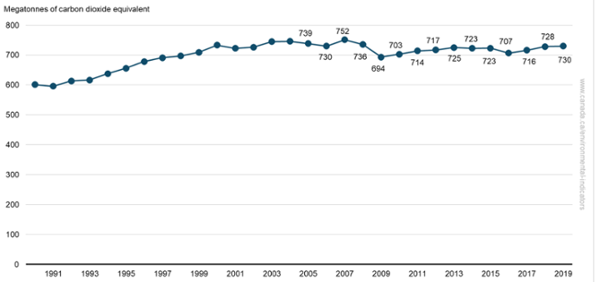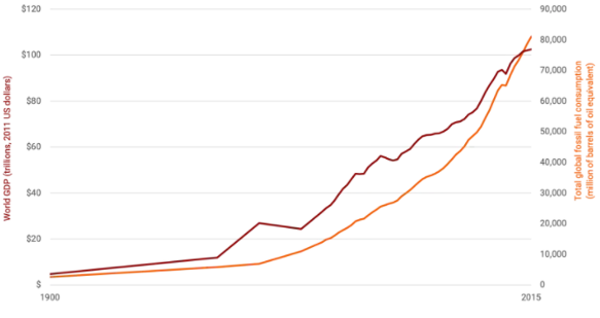
Addressing Climate Change and Economic Growth: Are they compatible?
Late this month, approximately 25,000 people representing more than 200 nations will gather in Glasgow, Scotland to tackle yet again the climate challenge facing the world. The Conference of the Parties, known as COP 26, has set four goals. Clearly the most important and overarching is for the world to reach net zero emissions by 2050 so that we can limit the increase in the global temperature to 1.5 degrees Celsius. It presents a herculean task. Based on the evidence of the last four decades following the first such climate summit in 1979, there is little reason for optimism.
By Dale Eisler, Senior Policy Fellow, Johnson Shoyama Graduate School of Public Policy and former federal Assistant Deputy MinisterLate this month, approximately 25,000 people representing more than 200 nations will gather in Glasgow, Scotland to tackle yet again the climate challenge facing the world. The Conference of the Parties, known as COP 26, has set four goals. Clearly the most important and overarching is for the world to reach net zero emissions by 2050 so that we can limit the increase in the global temperature to 1.5 degrees Celsius. It presents a herculean task. Based on the evidence of the last four decades following the first such climate summit in 1979, there is little reason for optimism.
The numbers don’t lie. Year after year, in spite of repeated lofty declarations to address rising global GHG emissions, the exact opposite has happened. Emissions have relentlessly increased. Globally in 1990, GHG emissions from the burning of fossil fuels for energy totaled 22.7 billion megatonnes. (A megaton is a million tonnes.) In 2019, the world total was 36.4 billion megatonnes. So over the course of 29 years, emissions increased by 60 per cent.1 During the same period global GDP rose by 79 per cent.2 The correlation between energy and growth is obvious. The same is true between energy consumption and quality of life.3
The fact the world has failed to meaningfully address climate change is not surprising. It is an issue unlike anything the world has ever collectively faced. Resolving multilateral issues is always fraught, as nations are political creations that instinctively act in their own self-interest. Think of the former General Agreement on Tariffs and Trade—now the World Trade Organization—which struggles to find a rules-based system simply to guide global trade. For that matter, consider long-standing internal trade barriers in Canada. Moreover, trying to create free trade within a single nation, when provinces act parochially by imposing rules to protect their economies, has long been unattainable in any significant way.
In terms of climate change, Canada produces only 1.6 per cent of global GHG emissions, yet it has been impossible so far to arrive at a national climate policy framework that will guide actions of governments to shape the economy in a coordinated manner. Now imagine trying to do the same with 200 nations, which have vastly divergent economies, standards of living, demographics, needs, expectations and political realities, to say nothing of the moral and ethical issues related to expecting poor nations to not have the benefits of cheap fossil fuel energy we have used to create our wealth. People can be excused if they can’t help but think the idea is fanciful that the global community will coordinate domestic environmental, economic and fiscal policies in a way that will reach global climate change outcomes.
In the days leading to the September 20 federal election this legacy of failure was noted by Monica Gattinger, Director of the Institute for Science, Society and Policy at the University of Ottawa. “Ottawa leaves a long trail of ambitious climate targets that it has failed miserably to achieve. The country has struggled to reduce emissions in the real worlds of federalism, reconciliation, community preferences, oil and gas production, investor confidence, regulatory systems and energy security. That both Conservative and Liberal governments have failed over the years is a testament to how challenging it is,” Gattinger says.4
The Hard Truths
But being difficult cannot be a reason for inaction. The world is clearly at a point of no return. In fact, one can argue that if significant progress that leads to measurable action to reduce GHG emissions starting now isn’t achieved at COP 26, then the 2050 goal of net zero emissions globally truly is a fiction.
The time has come for climate change to finally move beyond aspirational language of goal setting and the abstractions of lofty rhetoric, to the hard truths of what it takes to achieve the GHG reductions that have been set. Heading to Glasgow, it’s clear where Canada stands—a 40-45 per cent reduction in emissions from 2005 levels by 2030, on the way to a net zero emission economy by 2050.
So what does that actual mean, and imply?
The best way to understand the challenge is by looking at it in clear, and rather stark, terms. Canada currently emits approximately 730 megatonnes (million tonnes) of GHG emissions a year. If we are to reduce that by at least 40 per cent means a reduction of approximately 300 MT in less than nine years. The graph below shows GHG emissions in Canada over the course the last 30 years. The good news is GHG emissions in 2019 were the same as they were in 2005. The bad news is that emissions in 2019 were the same as they were in 2005, and they need to be at least 40 per cent lower in less than a decade. As the graph shows, since 1990, emissions increased by 21.4 per cent, or 129 Mt. During this period Canada’s emissions growth was largely driven by rising emissions from oil and gas extraction as well as transport.5 The driver underlying it was economic growth.
Figure 1: Greenhouse gas emissions, Canada, 1990 to 2019

This leads to obvious questions: What will it take to reach our goals? What are the economic considerations? What does it mean in terms of living standards for Canadians? To date few governments, or others actively engaged in the climate change debate, have dared to seriously answer those questions. The reason is simple: to address climate change people must change their energy consumption behaviour, which has given them the living standards they enjoy. It means using less energy by paying more for it.
The encouraging news is that finally there are signs the discussion is beginning to move from the realm of ambition, which for decades has characterized the climate change dialogue, to confronting the difficult facts. The central question is an economic one: are effectively addressing climate and continuing economic growth compatible? The answer from a growing chorus is “no”.
One of the earliest and most respected voices to argue that we cannot hope to sustain continuing economic growth—particularly in the developed world—and still address climate change, was University of Manitoba professor Vaclav Smil. It was a subject Smil explored in his 2019 book “Growth: From Microorganisms to Megacities.” His argument is that energy is the lifeblood of economic growth. All growth is energy based. Therefore, to be serious about climate change economic growth must be curtailed in the rich, developed world with resulting reductions in standards of living. At the same time poor and developing nations must be allowed to grow to close the inequity gap. “We could halve our energy and material consumption and this would put us back around the level of the 1960s. We could cut down without losing anything important,” Smil argues. “Growth must come to an end. Our economist friends don’t seem to realise that. The economists will tell you we can decouple growth from material consumption, but that is total nonsense. The options are quite clear from the historical evidence. If you don’t manage decline, then you succumb to it and you are gone. The best hope is that you find some way to manage it.”6
In his recent article in The Guardian exploring the intersection of growth and consumption with its environmental consequences, George Monbiot argues that “green growth” does not exist. He says it is “simply not possible to carry on at current level of economic activity without destroying the environment.” He makes the point that “this notion—that should be central to a new, environmental ethics—is secular blasphemy.”7
Then there is this from Mark Jaccard of Simon Fraser University and one of Canada’s foremost experts on climate change policy. “Don’t be tricked by ambitious targets with vague policy statements. Climate-insincere politicians learned early that naive voters would reward them for promising dramatic GHG reductions in a short time, which they subsequently never achieved once in office. This has been a deception by politicians across the political spectrum—Conservatives, Liberals, and the NDP. Greens often make extremely ambitious promises but have no chance of governing. When Greens participate in government, as occurs sometimes in Europe, their promises are less ambitious,” Jaccard argues. He goes on to say that governments take power and become paralyzed by their ambitious promises. “They quickly realize they can’t achieve them without great economic and political costs, so they don’t really try. Instead, they launch endless stakeholder policy processes as a delaying tactic. Ironically, voters who focus on targets inadvertently reward climate-insincere politicians and thus bear some responsibility for our climate crisis.”8
A Disingenuous Policy Debate
Aside from governments pandering for votes, often complicit in this disingenuous public policy debate are environmental groups who advocate for a transition to a “green” economy without ever confronting the tradeoffs and their inevitable economic and social consequences. Often the argument is nothing more than “we have no choice” because to not do what’s required risks catastrophic results for the planet. That’s a fair enough rhetorical position as far as it goes. But it does nothing to advance the cause of climate change. Nor does opposition by many in the environmental movement to non-emitting nuclear power, which is essential if we are to reach our climate objectives.
Follow the many threads to the climate change policy challenge and they all lead to the economy.
What needs to happen is a retooling of the global economy, which itself is mind-boggling. The fact is that fossil fuels—whether coal, oil, or natural gas—have been the dominant fuel for global growth for more than a century. And for good reason—they have been abundant, transportable and relatively cheap. Fossil fuels in 2019 accounted for 84 per cent of the world’s energy.9
Figure 2: GDP and Fossil Fuel Consumption

A green transition means rapidly decarbonizing the global economy, largely through the introduction of renewable energy sources such as wind and solar. That raises the critical issue of energy density, which is the amount of energy that can be stored in a given system, substance, region or space. Fossil fuels are far more energy dense than renewables. For solar and wind, mass cannot be used to define their energy density. Instead, power density per unit area is used. What that means is to equal the power generated by higher energy density fossil fuels, wind and solar need far greater use of land and resources.
This leads to one crucial element of many in the climate solution, which is electrifying the transportation sector. In other words, replacing gasoline with far greater generation of electricity to power electric vehicles. To do that will require huge amounts of raw materials and land because of lower power densities from wind and solar. In Canada, it’s estimated an area the size of half of Nova Scotia will be required. Another consideration is power density of battery storage. Current battery technology means that an electric car with a range of 360 miles would need a 1,334-pound battery. By comparison a gas-powered car with a 12.4 gallon tank carries 77.5 pounds of gasoline. A 77.5-pound battery would only carry an electric car 21 miles.10
Coupled with electrification of transportation are the implications for the existing power grid. Consider the case of Saskatchewan. In 2019 there were 917,568 road motor vehicles registered in Sask. A third were pickup trucks.11
For the fossil fuel energy used to power those vehicles to be supplied by the electrical grid would require a massive build out of the provincial energy grid, coupled with corresponding expansion of wind and solar power that would demand massive amounts of land.
The other key economic consideration embedded in climate policy is what many argue is the need for Canada to transition out of oil and gas production. It is a position that defies the nation’s history. Canada’s economic success, which has led to a standard of living and society envied around the world, has largely been the result of our comparative advantage in natural resources, which the world wants and needs. As a trading nation heavily dependent on exports to the global economy, oil and gas have been Canada’s single most important exports.
Consider the facts. The energy sector in 2019 contributed a net $76.6 billion to the Canada’s current account. It was enough to pay for net consumer imports ($55 billion) and autos ($22 billion). Of the energy total, 80 per cent came from crude oil and bitumen, and natural gas brought the share above 90 per cent. In the 2008-09 recession it was fossil fuels and other resources that kept the economy from cratering. Without the foreign revenue for fossil fuels, the Canada dollar exchange rate would plummet.12 At this point, there is nothing evident that would replace the export revenue if Canada were to scale back its oil and gas production and retreat from the global energy market. We have no comparative advantage in renewable energy—which is not a commodity transportable like oil and gas—that would allow it to come anywhere close to replacing the lost revenue from fossil fuel exports.
Aside from the huge technological and distribution challenges of replacing fossil fuels with renewable energy, are the economic and fiscal costs. On a global scale the IEA estimates that $15 trillion will have to be invested in renewable energy to generate the capacity required to displace fossil fuels. Inherent in wind and solar is the need for metals, largely silver, which the World Bank says could increase demand from 24,000 tons annually, to 700,000 tons and bring its own environmental challenges.13 In terms of Canada, based on a 2020 study by the Institute for Sustainable Finance at Queen’s University the total investment necessary to meet our original 30 per cent GHG reduction commitment by 2030 would be $128 billion over the next 10 years.14 That figure is certainly not beyond our nation’s capacity, but it also means bypassing other investments.
Sadly, there is a large gap between climate change aspirational statements expressed in goal setting and vagueness about the concrete measures to achieve them. Is the public willing to accept $3-4 per litre gasoline prices? Are large cuts in natural resource sector employment politically sustainable? Those are the very issues that ignite populist backlash and are central to the climate change agenda.
Conclusion
The critical variable underlining all the economic issues that come with a serious climate change agenda is public opinion. Successful and effective public policy hinges on public acceptability. To date government and others engaged in the climate debate have failed to prepare the public for the real and measurable impacts on their lives if we are to meet out climate targets. The reason is simple: they know the political risk that comes with being honest about what it’s going to take. But all that avoiding the truth does is ensure we continue down the path of the last four decades where we set impressive targets, and then never meet them. The day of reckoning is fast approaching.
ISSN 2369-0224 (Print) ISSN 2369-0232 (Online)
References
[1] https://ourworldindata.org/co2-emissions
[3] Energy and quality of life - ScienceDirect
[7] https://www.theguardian.com/commentisfree/2021/sep/29/green-growth-economic-activity-environment
[8] https://www.nationalobserver.com/2021/09/14/opinion/climate-crisis-elections-urgent-honesty
[9] https://www.iea.org/reports/key-world-energy-statistics-2020
[10] https://www.brookings.edu/essay/why-are-fossil-fuels-so-hard-to-quit/
[12] David Dodge, Two Mountains to Climb: Canada’s Twin Deficits and How to Scale Them, Public Policy Forum, Sept. 2020
[14] Centres and Services - The Institute for Sustainable Finance - Research - Capital Mobilization Plan (queensu.ca)Dale Eisler

Prior to joining the Johnson Shoyama Graduate School of Public Policy, Dale Eisler spent 16 years with the Government of Canada in a series of senior positions, including as Assistant Deputy Minister Natural Resources Canada; Consul General for Canada in Denver, Colorado; Assistant Secretary to Cabinet at the Privy Council Office in Ottawa; and, Assistant Deputy Minister with the Department of Finance. In 2013, he received the Government of Canada’s Joan Atkinson Award for Public Service Excellence. Prior to joining the federal government, Dale spent 25 years as a journalist. He holds a degree in political science from the University of Saskatchewan, Regina Campus and an MA in political studies from Vermont College. He also studied as a Southam Fellow at the University of Toronto, and is the author of three books, including Anton, a historical fiction novel that has been turned into a feature film.

